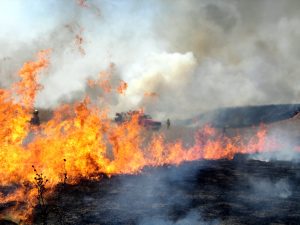
A controlled burn study at the Konza Prairie Biological Station (KPBS) in Kansas, used to study the effects of fire on the tallgrass prairie ecosystem.
Credit: Eva Home
The majority of grasslands around the world have been destroyed or converted for human use, either for agricultural or urban development. In North America, for example, only four percent of the once vast tallgrass prairies are left. Understanding grassland community dynamics could be a critical part of conserving those that remain.
Plant-pollinator relationships are of particular importance in grassland systems because the majority of grassland plant species depend on insect pollination. In the face of current global pollinator declines, researchers from the Konza Prairie LTER aimed to evaluate the resistance of plant-pollinator communities to species loss under different disturbance regimes. The team found that both bison grazing and burn treatments significantly altered plant and floral visitor community composition and structure.
The research team used ecological network analysis to evaluate how fire frequency and grazing affect the network structure of plant-pollinator relationships and the resulting resistance to species loss. The ecological network approach provides a useful framework to examine shifts in the interactions between plants and their associates. The technique emphasizes the importance of species interactions, describes inherent community-level structural properties among interacting species groups, and examines how network structural properties such as redundancy and proportion of generalists versus specialists affect community resistance to extinctions.
Researchers found that bison grazing increased flowering plant species richness, network floral visitor species richness, and decreased network nestedness. Bison seem to prefer grazing on wind-pollinated grass species, allowing insect-pollinated species to flourish. The higher flower species richness and higher network insect species richness in grazed watersheds are probable causes of the decrease of nestedness in grazed watersheds, mirroring previous reports of decreasing nestedness with network species richness.
Fire frequency also affected the community composition of flowering plants and floral visitors. Increased burn frequency reduced the species richness of forbs, the primary insect-pollinated flowering plants in grassland systems. However, the absence of fire, particularly combined with the absence of grazers, resulted in the dominance of weedy flowering plants. According to the researchers, an intermediate burn interval may therefore present the best balance between maximizing forb diversity and reducing weedy species.
Understanding relationships between multiple environmental drivers and community network structure helps to predict changes in ecological communities under changing habitat conditions and provides useful management options for maintaining resistant plant-floral visitor networks in grassland ecosystems.
-Kristen Weiss
Source: Welti, E.A.R. & Joern, A. Fire and grazing modulate the structure and resistance of plant-floral visitor networks in a tallgrass prairie. Oecologia (2018) 186: 517. https://doi.org/10.1007/s00442-017-4019-9
Related data: Welti E., A. Joern. 2018. ESM01 Fire and grazing modulate the structure and resistance of plant floral visitor networks in a tallgrass prairie. Environmental Data Initiative. http://dx.doi.org/10.6073/pasta/99aa42c69fe55fa99b81c251ea04e213.










